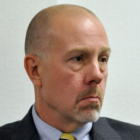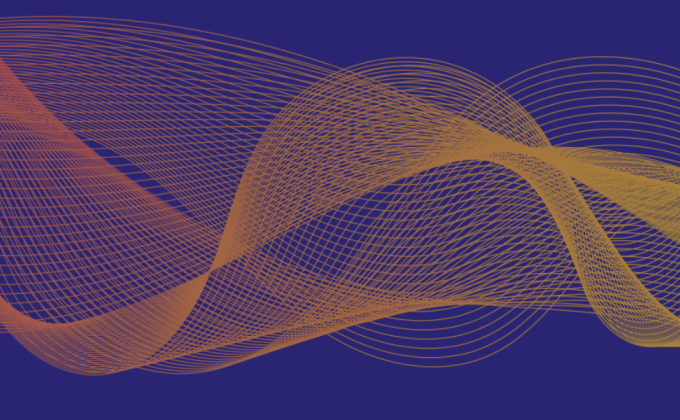Counter-Terrorism After 9/11 is a podcast series exploring how counter-terrorism has changed in the aftermath of the terrorist attacks on September 11th, 2001.
In our premiere episode, we speak to Frank Straub, Director of the Center for Mass Violence Response Studies at the US National Police Foundation.
Twenty years ago, Frank was a first responder on the scene of the attacks in lower Manhattan. Looking back, we go through his experience of the day and his perspective on how counter-terrorism in policing changed after the attacks. Interviewing him is Dr. Joana Cook, an ICCT Senior Project Manager and Editor-in-Chief of the ICCT Journal.
You can listen to Counter-Terrorism After 9/11 using the audio player below or through your favourite podcast player (Spotify, Apple, Google, Breaker, Pocket Casts, RadioPublic). Below is a transcript of the interview, which has been shortened and adapted for publication.
Warning: This story contains graphic details related to the events of 9/11.
JOANA COOK: Dr. Straub, thanks for joining us today. Can you please introduce yourself to our audience?
FRANK STRAUB: I'm the director of the National Police Foundation's Center for Mass Violence Response Studies. I joined the Police Foundation approximately five and a half years ago, after spending thirty years in federal, state and local law enforcement in the United States. Early in my career, I worked in the counter-terrorism, counter-extremism space with the US State Department, and the US Naval Investigative Service. I left and then joined the US Department of Justice Inspector General's office with the intent of working on public corruption cases. In 1993, when the first attack on the World Trade Centre happened, I ended up becoming involved in that investigation as a result of an individual that we had arrested on bribery charges.
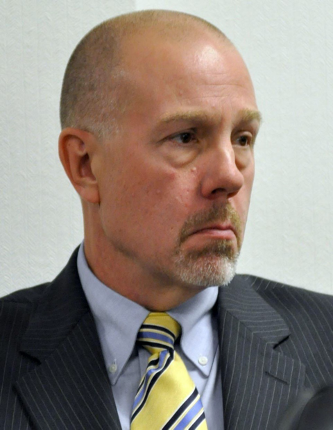
Frank Straub
About two weeks after the 9/11 attack, I joined the NYPD as the Deputy Commissioner of Training. I served in that position for about six months and then I was asked to help stand up the counter-terrorism division in the New York City Police Department. After doing that, I went up to a small community about thirty miles north of New York, where I was the Public Safety Commissioner and was there for about nine years and then left and went out to Indianapolis, Indiana, as the Public Safety Director for the city, and then out to Spokane, Washington, where I was the Police Chief. I then joined the National Police Foundation.
COOK: Where were you on the morning of 9/11? What do you remember from that day?
STRAUB: I was working about six blocks south of the World Trade Centre complex. While I was in the elevator, I felt the building shake. I got down to the ground floor and went outside and everybody was looking at the World Trade Centre. I looked up at it, it was an absolutely crystal clear day, and it was clear that a rather large aircraft had hit the tower. From my perspective, it was impossible that it was an accident for a plane, a commercial aircraft, to hit that building. [Based on] my work in the 1993 case, and my work in the Terrorism Task Force, I concluded pretty quickly that this was an intentional attack.
I went back upstairs to find out what was happening. Shortly after getting upstairs and turning on the TV, the second plane hit. The whole building shook and one of the investigators that worked for me, and I, decided that we were going to go and see what we could do to help out. We walked out the back door of the building, and I can still see this today. The first thing we saw were body parts. Remember we're six blocks south of the building. All kinds of human tissue to the point that we had to be very intentional to step over [them as we made our way up to the World Trade Center]. In making our way up to the towers, we witnessed many of the people who were jumping from the towers or hanging from windows that had been blown out.
When we got to the towers, we came across a friend of Pete, who was the retired New York City detective I was with. He knew the [FDNY] Captain, who was with a group of firefighters going into the building. We had a brief exchange with them. Probably ten minutes later, the first building started to come down, and we were fortunate enough to be able to get across the street and behind a building. The firefighters were killed in the collapse.
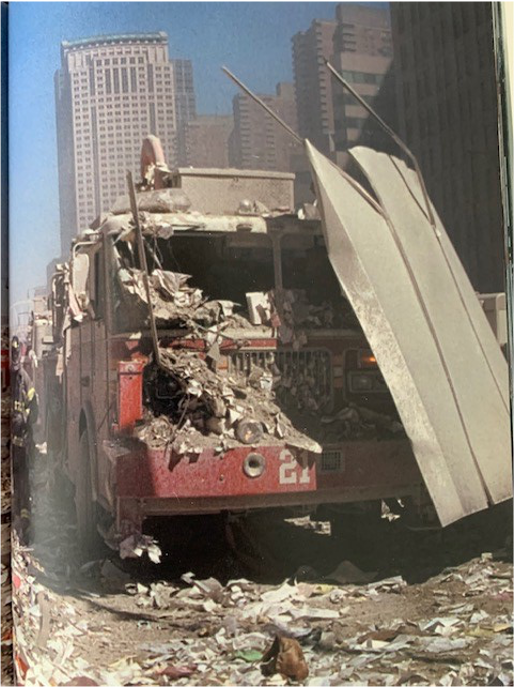
The fire truck Frank hid under as Tower 2 collapsed. Photo Rights: Frank Straub
When light started to return, we came out from under the fire truck and pretty much everything was on fire. It was kind of like coming out into hell. Some of the ammunition in the police vehicles started to explode. I didn't realise that my whole back was covered with blood and other fluids and it turned out that one of the people that was running behind us didn't make it under the fire truck. I ended up with two scratched corneas but other than that, I was okay.
We stayed and tried to help as much as we could through the next couple of weeks, and went back intermittently, and worked on what has been referred to as "the pile", trying to help. We thought initially to rescue people, but really, to recover remains. And then October 1st, I joined the NYPD as the Deputy Commissioner of Training.
COOK: For many people that work in the field of counter-terrorism, 9/11 remains one of these foundational moments. How have the events of 9/11 impacted your own career path?
STRAUB: The New York City Police Department, when I got there, my first mandate was to reimagine, reinvent if you will, counter-terrorism training for, at that point a 52,000-person organisation. The training at that point was really still focused on the Weather Underground, the Black Liberation Army and the FALN and so on. Despite the 1993 attack, there really was little focus and attention being paid to the threat that we saw manifest itself. We had to do it very quickly, because it wasn't just the attack, we now were pretty convinced, and the intelligence suggested, that there will be follow up attacks, particularly on the New York City subway. I was charged with developing roll call training, for all of our uniformed and civilian staff, and getting it out there as quickly as possible.
You have to also put this in the context of a department that's been devastated by this event, this was very personal. Despite the pain, and the sorrow, my staff rallied, and in four months, we produced video training elements that were informed by law enforcement officials and some of the best scientists in the world, around a potential attack on the subway, and what that might look like and what officers could do to prepare for that. We looked at biological and chemical weapons, we looked at dirty bombs. Probably the biggest issue was, what do we do with a suicide bomber? We had never contemplated that, nationally or locally. How did that fit into use of force? How did that fit into the US Constitution, in terms of, in many regards, having to make a decision as to whether you would preemptively use force, versus use force in response to a threat, right? Against you or an officer or the community?
So we developed those modules, but right in the middle of that, anthrax hit. So we had an actual chemical attack on the United States. It turned out not to be a foreign attack by every indication, but we had to wrestle with that. So there were these initial responses, how do we really think about this new threat environment, and how do we respond to it?
COOK: What have been the most significant changes from the events of 9/11 related to policing and training for police and mass incident cases like this, or where terrorism was suspected?
STRAUB: We had deficient intelligence sharing at both the federal level, and between the federal government and local law enforcement. We were still very much in the beginning stages of integration of federal and local law enforcement through Terrorism Task Forces.
I think we missed a lot of the indicators. We didn't shift gears well enough and quickly enough, after the 1993 bombing. Some of the events, the USS Cole and other things, should have been really jumping out at us as warning signs. We've done the same thing with domestic terrorism, we really missed this undercurrent of nationalist movements and white supremacy in the United States. It was becoming so powerful and so impactful, and so energised, that a large group of people would try to overthrow the United States Congress. There were political issues and political rhetoric that influenced that, but I think one of the major lessons for all of us that are in this space, is not to be myopic, but really to challenge ourselves every day to be thinking about what is the current threat environment? What does that threat environment suggest to us is necessary in terms of response, at a local level, and a national level, and an international level?
COOK: What are the biggest issues that have really shaped and impacted how policing is imagined in this counter-terrorism space, domestically within the US?
STRAUB: Initially, we had a very strong, quasi-militaristic response. We really saw the growth or the reinvigoration of tactical teams. In New York City, there were special units that were created to protect critical infrastructure, major tourism spaces, and that was done with a show of force. That happened throughout the country. We also saw a very energised intelligence gathering process. We realised that it was necessary to go out and hire in New York, much more diversity in terms of language skills and abilities. We also realised that we had to really engage, not only persons from the Middle East, but, really new immigrants more broadly. That really created the whole countering violent extremism (CVE) process, in terms of trying to get members of those communities to collaborate with law enforcement at both the local and federal level, to identify individuals that were either at risk or potentially were being radicalised.
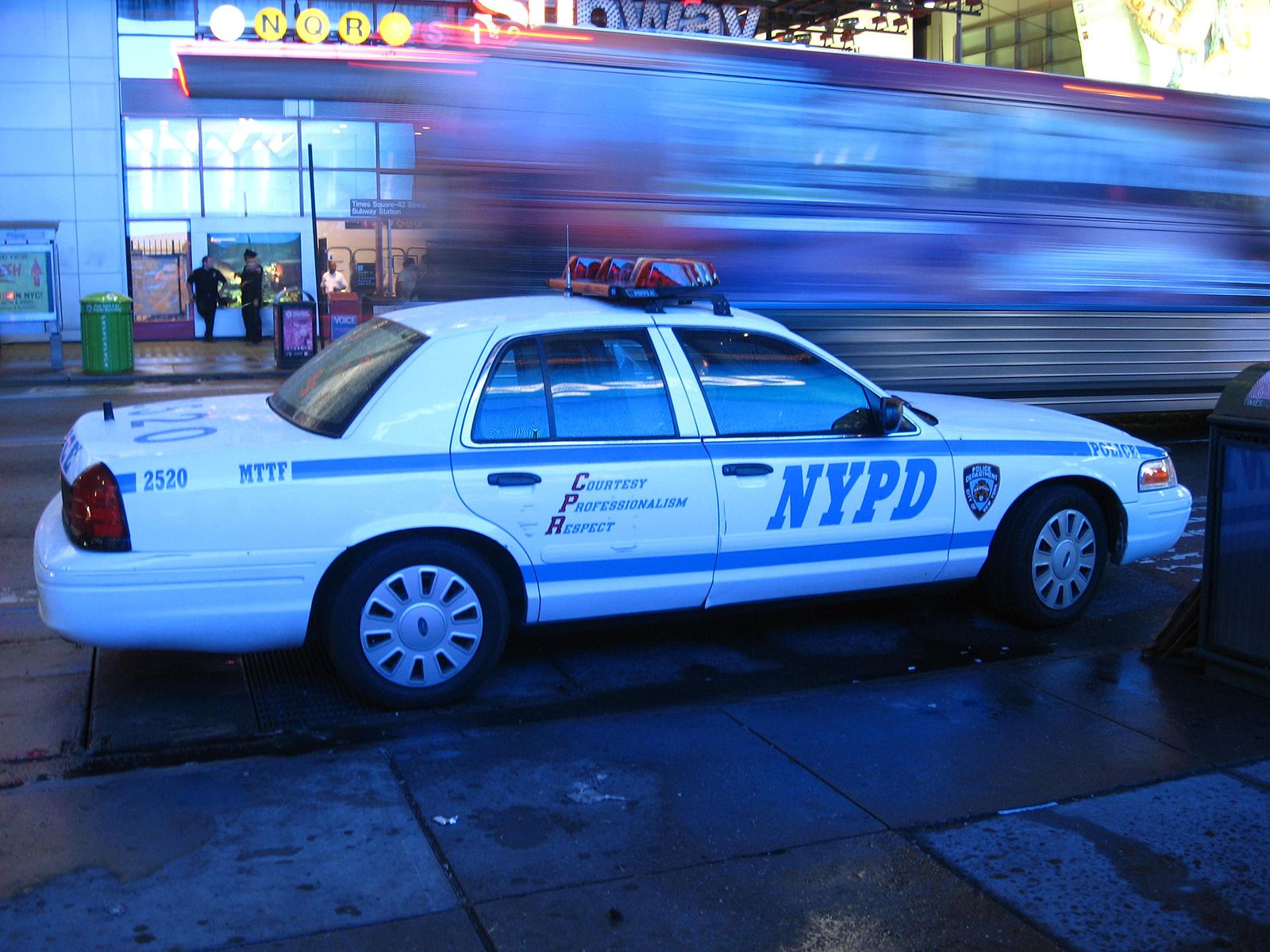
Photo: Wikimedia Commons
We saw the creation of the Department of Homeland Security (DHS), I think it's still an area of debate as to whether that's successful. We saw the growth of the Terrorism Task Forces throughout the country, which has been incredibly important in terms of aligning local and federal level resources in intelligence sharing. We also saw the development of fusion centres throughout the United States, both at the local and federal level and combined intelligence centres, which have been incredibly important.
We also saw a very visceral public reactions to some of this, both the tactical, and in the intelligence and CVE. To some degree, it is because were building the airplane at the same time were flying it. We're struggling to figure out how do we deal with this threat environment, both current and emerging. Sometimes in the process of building the plane while you're trying to get from point A to point B, maybe you're over-aggressive in certain areas. We are overly aggressive in certain communities and so we've had to tweak our responses and our strategies. That's something that needs to be done on a very regular basis and a continuing basis.
I think we are doing much better, both nationally and internationally. I think we still are challenged by cyberspace, particularly at the local level. I don't think that the majority of police agencies are conversant in social media. That's an area that we really need to focus on - the whole social media piece.
COOK: In relation to policing and either counter-terrorism specifically, or some of the broader work on CVE, what other areas could use further development?
STRAUB: The biggest challenge that we face, and I believe we're going to continue to face, is how do you carry on effective counter-extremism, counter-terrorism operations in a democracy? How do you do that in a way that protects in our country, the first amendment rights, freedom of speech? The right to bear arms in a way that protects local communities and protects the nation, again, without violating those rights? There clearly is no easy answer to this.
Having 18,000 very different police departments and a federal law enforcement environment, and trying to get those to align is also very challenging. I think we are doing a better job of working together. I think we are listening to the communities that we serve, and recognising the impact that we have when we engage in CVE work, and I think that's helping the process. It’s helping us build trust in communities where we need that trust in order to disrupt radicalization efforts.
COOK: Can you expand more on the relationship of police and communities working together in the CVE space?
STRAUB: It's critical, we can't do the work that we do, to protect our communities and our country, unless we do it in collaboration with a community. This goes beyond terrorism, extremism, it really goes to targeted violence, and mass violence, more generally. We need the community to feel comfortable when they see something that suggests, or is, concerning behaviour, reporting that to the police, recognising that the police will, in fact take appropriate action and resolve the issue. We would hope that the vast majority of issues can be resolved through early intervention and don't even have to end up in the criminal justice system.
I think it's also the community's obligation to tell us what we're getting right and what we're getting wrong, versus waiting until we've done something that really is so egregious that now it has caused a crisis. That open and honest dialogue, really is essential to building effective policies, practices and strategies. We can't do it without the community. I mean, it's really that that simple, because it's the community we're trying to protect. It's the community that has the greatest insight. We need to be able to draw on that insight, both in the development stage and the implementation stage. Also in the evaluation stage to make sure that we're not having adverse impacts or violating people's rights in the process of trying to prevent terrorism or extremism or more.
COOK: How have you viewed this process in terms of working with different community partners and really trying to find that balance of actors coming together in this space?
STRAUB: We did a programme in Boston, a CVE programme funded by DHS a few years ago. It was with the Somali community, we really needed the Somali community to be a part of it. The premise of what we did was based on building relationships and working through stereotypes between young Somali youth and the Boston Police Department and the Boston Transit Police. We engaged a nonprofit organisation that I had worked with for many years, around reducing youth violence by building these relationships of trust, and so we used that programme as the premise for our CVE work. We brought, over the course of the year, probably about 100 young women and men into meetings, focus groups, if you will, with Boston Police officers.
The whole idea was to break through stereotypes. There's a tremendous lack of understanding in police departments, generally, I would say in American communities generally, about the Somali community. Having that conversation and giving these young women and men the opportunity to really increase the knowledge that these officers had of Somali communities and customs and beliefs, but also giving the officers an opportunity to explain to these young women and men, why they wear the equipment they do and why they act in certain ways, was incredibly impactful. These were human interactions that went beyond what somebody wore, or what their role was, but they were people conversing. That became a very powerful tool, it was recognised by DHS as one of the ten model programmes in that space.
Much of this work, really boils down to human relationships, building trust at the individual level, and the organisational and community level, working through these barriers in terms of understanding. When that happens, maybe some of these communities don't feel like they're disenfranchised, that they're isolated from the broader community. Maybe it creates these opportunities to build bridges. When people feel isolated, when they feel like they're being treated as something different and something other, and they're pushed away, that only reinforces in some cases, their perceived grievances, their anger, their frustration. When you have those emotions building up, particularly in communities that have been highly traumatised, it becomes this potential breeding ground for extremist ideology to ferment and to take root. It becomes incredibly important to break down those barriers, to break down isolation, to create effective avenues of communication.

Photo: Frank Straub
COOK: What is the biggest lesson learned, particularly from the view of policing in these last 20 years?
STRAUB: We have to remain ever vigilant. Regardless of what other challenges are out there, whether it's COVID, or something else, we can't lose sight of the fact that there are people in the world, or in the United States, that are intent on committing acts of violence, that are committed to disrupting our democracy, that are intent on advancing a really different ideology across the world.
When we let our guard down, that's when we see, sadly, attacks like 9/11. We have to be committed, and we have to maintain that whole community approach, both in challenging times and in times when it's really working. We always have to be thinking about what's next. Is there another group emerging? Is there a new threat emerging? How are we going to counter that? We have to be in this process of risk identification, and risk mitigation, versus crisis response.
COOK: Looking at the domestic environment in the US, what does that look like specifically to you?
STRAUB: We have some very highly traumatised and disenfranchised communities and groups in the US. We have people that are part of white nationalist organisations, white supremacist organisations, who clearly feel very isolated, very disenfranchised. They have a number of grievances, whether they're real or imagined. We have to pay attention to try to figure out what that dynamic is, what that trauma is, and how do we bring those disparate groups to the table. Similarly, we have members of communities of colour, that have feelings of trauma and isolation and disenfranchisement. We have a very fragmented situation, a very volatile situation.
How do we calm down the political rhetoric at a national level, at a local level? How do we identify members of these disparate groups? How do we find a common language and strategy that allows us to break down these barriers that have developed, particularly over the past five to six years and become so energised and so volatile? So that we can re-engage these individuals, we can figure out where their grievances are and try to allay some of those grievances? I think that it’s not just in the United States, I think it's across the world. We really have to think about a multi-pronged strategy that we're going to use to, not only protect our communities and our nation, but to address the issues of trauma and isolation so that we can decrease opportunities for radicalization and energising of these various groups.
COOK: Is there a final message you'd like to leave with our audience today?
STRAUB: We need empirical evidence to support the work we're doing. Sometimes we tend to go off and we respond with the cliché term of knee jerk reactions. Maybe if we slowed the response down a little bit, and really tried to understand what the data suggested, our strategies would be longer lasting and more impactful. So I greatly appreciate and applaud the work of you and your colleagues. The students that are interested in this field, they're the future. If we can train them, with a very humanistic strategy, as the baseline from which we operate, we get folks to understand trauma in isolation. We use that as the foundation from which we develop our strategies. I think we can go a long way in protecting our communities.
This 20th anniversary is a very good time to pause, to think about where we are and where we need to be. To remember what happened, because we shouldn't live in history, but we should certainly recognise aspects of history that give us the opportunity to inform our current decision making and approach, as well as our approach to future challenges and opportunities.
COOK: Thank you so much.
STRAUB: Thank you.
Photocredit: ICCT/Canva

